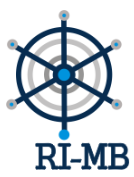
Use este identificador para citar ou linkar para este item:
https://www.repositorio.mar.mil.br/handle/ripcmb/847884| Título: | Metagenomic insights Into ecosystem function in the microbial mats of a large hypersaline Coastal Lagoon System |
| Autor(es): | Walter, Juline Marta Oliveira, Louisi Souza de Tschoeke, Diogo Antonio Meirelles, Pedro Milet Neves, Maria Helena Campos Baeta Batista, Daniela Carvalho, Ana Polycarpa Costa, Rafaela dos Santos Dobretsov, Sergey Coutinho, Ricardo Swings, Jean Thompson, Cristiane Carneiro Thompson, Fabiano L. |
| Palavras-chave: | Lagoa de Araruama Microbioma Biofilme |
| Áreas de conhecimento da DGPM: | Biotecnologia marinha |
| Data do documento: | 2021 |
| Editor: | Frontiers in Marine Science |
| Descrição: | . |
| Abstract: | The hypersaline lagoon system of Araruama (HLSA) is one of the largest in the world and one of the most important sources of evaporative salt in Brazil. The biogeochemical characteristics of this lagoon system led it to be considered a Precambrian relic. The HLSA also harbors extensive microbial mats, but the taxonomic and metabolic attributes of these mats are poorly understood. Our high-throughput metagenomics analyses demonstrated that the HLSA microbial mats are dominated by Proteobacteria, Cyanobacteria, and Bacteroidetes. Among Proteobacteria, Deltaproteobacteria comprises approximately 40% of the total population and it includes sulfate-reducing bacteria such as Desulfobacterales, Desulfuromonadales, and Desulfovibrionales. Differing in composition and function of their reaction centers, other phylogenetic diverse anoxygenic phototrophic bacteria were detected in the HLSA microbial mats metagenomes. The presence of photolithoautotrophs, sulfate reducers, sulfide oxidizers, and aerobic heterotrophs suggests the existence of numerous cooperative niches that are coupled and regulated by microbial interactions. We suggest that the HLSA microbial mats hold microorganisms and the necessary machinery (genomic repertoire to sustain metabolic pathways) to promote favorable conditions (i.e., create an alkaline pH microenvironment) for microbially mediated calcium carbonate precipitation process. Metagenome-assembled genomes (Ca. Thiohalocapsa araruaensis HLSAbin6 sp. nov. and Ca. Araruabacter turfae HLSAbin9 gen. nov. sp. nov.) obtained support the relevance of Sulfur metabolism and they are enriched with genes involved in the osmoadaptive networks, hinting at possible strategies to withstand osmotic stress. Metabolically versatile bacteria populations, able to use multiple nutrient sources and osmolytes, seem to be a relevant attribute to survive under such stressful conditions. |
| Tipo de Acesso: | Acesso aberto |
| URI: | https://www.repositorio.mar.mil.br/handle/ripcmb/847884 |
| ISSN: | 2296-7745 |
| Tipo: | Artigo científico |
| Aparece nas coleções: | Ciência, Tecnologia e Inovação: Coleção de Artigos |
Arquivos associados a este item:
| Arquivo | Descrição | Tamanho | Formato | |
|---|---|---|---|---|
| Metagenomic Insights Into Ecosystem Function in the Microbial Mats of a Large Hypersaline Coastal Lagoon System - Artigo (Louisi).pdf | Artigo - Louisi de Souza Oliveira | 2,98 MB | Adobe PDF | Visualizar/Abrir |
Os itens no repositório estão protegidos por copyright, com todos os direitos reservados, salvo quando é indicado o contrário.